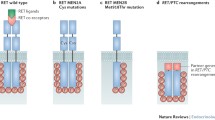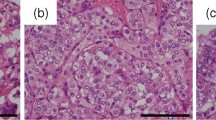Abstract
Rearranged during transfection (RET) is a proto oncogene implicated in thyroid carcinogenesis of papillary type (PTC). The RET proto-oncogene in PTC is constitutively activated by fusion of its tyrosine kinase domain with the 5 ´region of another gene thereby generating chimeric products collectively named RET/PTCs. RET/PTC1 and RET/PTC3 are best characterized among all RET/PTC rearrangements. Kashmir valley has witnessed an alarming increase in thyroid cancer incidence in young women. Therefore, we investigated the occurrence of RET/PTC 1 & 3 rearrangements by semi quantitative and qPCR in thyroid cancer patients (n = 48) of Kashmiri population and interrelated results with various clinicopathological characteristics. We observed that all the RET/PTC rearrangements were confined to PTC cases (10/40). Presence of RET/PTC rearrangement significantly correlated with gender, elevated TSH levels and lymph node metastasis. Overall, our study advocates that RET/PTC3 rearrangement is a frequent event in the carcinogenesis of thyroid gland in Kashmiri population although a study with a larger sample size is needed to get a clear scenario.



Similar content being viewed by others
References
Pellegriti G, Frasca F, Regalbuto C, Squatrito S, Vigneri R (2013) Worldwide increasing incidence of thyroid cancer: update on epidemiology and risk factors. J Cancer Epidemiol 2013:1–10. https://doi.org/10.1155/2013/965212
La Vecchia C, Malvezzi M, Bosetti C et al (2015) Thyroid cancer mortality and incidence: a global overview. Int J Cancer 136:2187–2195. https://doi.org/10.1002/ijc.29251
Liu Y, Su L, Xiao H (2017) Review of factors related to the thyroid Cancer epidemic. Int J Endocrinol 2017:1–9. https://doi.org/10.1155/2017/5308635
Xing M (2013) Molecular pathogenesis and mechanisms of thyroid cancer. Nat Rev Cancer 13:184–199. https://doi.org/10.1038/nrc3431
Marotta V, Guerra A, Sapio MR, Vitale M (2011) RET/PTC rearrangement in benign and malignant thyroid diseases: a clinical standpoint. Eur J Endocrinol 165:499–507 https://doi.org/10.1530/EJE-11-0499
Santoro M, Carlomagno F (2013) Central role of RET in thyroid cancer. Cold Spring Harb Perspect Biol 5:1–17. https://doi.org/10.1101/cshperspect.a009233
Kurokawa K, Kawai K, Hashimoto M, Ito Y, Takahashi M (2003) Cell signalling and gene expression mediated by RET tyrosine kinase. J Intern Med 253:627–633
Nikiforov YE (2002) RET/PTC rearrangement in thyroid tumors. Endocr Pathol 13:3–16. https://doi.org/10.1385/EP:13:1:03
Tong G-X, Mody K, Wang Z, Hamele-Bena D, Nikiforova MN, Nikiforov YE (2015) Mutations of TSHR and TP53 genes in an aggressive clear cell follicular carcinoma of the thyroid. Endocr Pathol 26:315–319 https://doi.org/10.1007/s12022-015-9388-1
Khan MS, Pandith AA, Azad N, Hussain MU, Masoodi SR, Wani KA, Andrabi KI, Mudassar S (2014) Impact of molecular alterations of BRAF in the pathogenesis of thyroid cancer. Mutagenesis 29:131–137
Khan MS, Pandith AA, Hussain MU, Iqbal M, Khan NP, Wani KA, Masoodi SR, Mudassar S (2013) Lack of mutational events of RAS genes in sporadic thyroid cancer but high risk associated with HRAS T81C singlenucleotide polymorphism (case–control study). Tumor Biol 34:521–529
Jhiang SM (2000) The RET proto-oncogene in human cancers. Oncogene 19:5590–5597. https://doi.org/10.1038/sj.onc.1203857
Romei C, Ciampi R, Elisei R (2016) A comprehensive overview of the role of the RET proto-oncogene in thyroid carcinoma. Nat Rev Endocrinol 12:192–202 https://doi.org/10.1038/nrendo.2016.11
Thomas GA, Bunnell H, Cook HA et al (1999) High prevalence of RET/PTC rearrangements in Ukrainian and Belarussian post-Chernobyl thyroid papillary carcinomas: a strong correlation between RET/PTC3 and the solid-follicular variant. J Clin Endocrinol Metab 84:4232–4238. https://doi.org/10.1210/jcem.84.11.6129
Hamatani K, Eguchi H, Ito R, Mukai M, Takahashi K, Taga M, Imai K, Cologne J, Soda M, Arihiro K, Fujihara M, Abe K, Hayashi T, Nakashima M, Sekine I, Yasui W, Hayashi Y, Nakachi K (2008) RET/PTC rearrangements preferentially occurred in papillary thyroid Cancer among atomic bomb survivors exposed to high radiation dose. Cancer Res 68:7176–7182 https://doi.org/10.1158/0008-5472.CAN-08-0293
Bounacer A, Wicker R, Schlumberger M, Sarasin A, Suárez HG (1997) Oncogenic rearrangements of the ret proto-oncogene in thyroid tumors induced after exposure to ionizing radiation. Biochimie 79:619–623. https://doi.org/10.1016/S0300-9084(97)82012-3
Mayr B, Pötter E, Goretzki P, Rüschoff J, Dietmaier W, Hoang-Vu C, Dralle H, Brabant G (1998) Expression of ret/PTC1, −2, −3, −delta3 and −4 in German papillary thyroid carcinoma. Br J Cancer 77:903–906
Zou M, Shi Y, Farid NR (1994) Low rate of ret proto-oncogene activation (PTC/retTPC) in papillary thyroid carcinomas from Saudi Arabia. Cancer 73:176–180
Lee CH, Hsu LS, Chi CW et al (1998) High frequency of rearrangement of the RET protooncogene (RET/PTC) in Chinese papillary thyroid carcinomas. J Clin Endocrinol Metab 83:1629–1632. https://doi.org/10.1210/jcem.83.5.4774
Chua EL, Wu WM, Tran KT et al (2000) Prevalence and distribution of ret/ptc 1, 2, and 3 in papillary thyroid carcinoma in New Caledonia and Australia. J Clin Endocrinol Metab 85:2733–2739. https://doi.org/10.1210/jcem.85.8.6722
Detection of RET/PTC oncogene rearrangements in Korean papillary thyroid carcinomas. - PubMed - NCBI. https://www.ncbi.nlm.nih.gov/pubmed/10646664. Accessed 5 Apr 2018
Wajjwalku W, Nakamura S, Hasegawa Y, Miyazaki K, Satoh Y, Funahashi H, Matsuyama M, Takahashi M (1992) Low frequency of rearrangements of the ret and trk proto-oncogenes in Japanese thyroid papillary carcinomas. Jpn J Cancer Res Gann 83:671–675
Smida J, Salassidis K, Hieber L, Zitzelsberger H, Kellerer AM, Demidchik EP, Negele T, Spelsberg F, Lengfelder E, Werner M, Bauchinger M (1999) Distinct frequency of ret rearrangements in papillary thyroid carcinomas of children and adults from Belarus. Int J Cancer 80:32–38
Gandhi M, Dillon LW, Pramanik S, Nikiforov YE, Wang YH (2010) DNA breaks at fragile sites generate oncogenic RET/PTC rearrangements in human thyroid cells. Oncogene 29:2272–2280 https://doi.org/10.1038/onc.2009.502
Adeniran AJ, Zhu Z, Gandhi M, Steward DL, Fidler JP, Giordano TJ, Biddinger PW, Nikiforov YE (2006) Correlation between genetic alterations and microscopic features, clinical manifestations, and prognostic characteristics of thyroid papillary carcinomas. Am J Surg Pathol 30:216–222
Su X, Li Z, He C, Chen W, Fu X, Yang A (2016) Radiation exposure, young age, and female gender are associated with high prevalence of RET/PTC1 and RET/PTC3 in papillary thyroid cancer: a meta-analysis. Oncotarget 7:16716–16730. https://doi.org/10.18632/oncotarget.7574
Tallini G, Asa SL (2001) RET oncogene activation in papillary thyroid carcinoma. Adv Anat Pathol 8:345–354
Grubbs EG, Ng PK-S, Bui J, Busaidy NL, Chen K, Lee JE, Lu X, Lu H, Meric-Bernstam F, Mills GB, Palmer G, Perrier ND, Scott KL, Shaw KR, Waguespack SG, Williams MD, Yelensky R, Cote GJ (2015) RET fusion as a novel driver of medullary thyroid carcinoma. J Clin Endocrinol Metab 100:788–793. https://doi.org/10.1210/jc.2014-4153
Guerra A, Sapio MR, Marotta V et al (2011) Prevalence of RET/PTC rearrangement in benign and malignant thyroid nodules and its clinical application. Endocr J 58:31–38
Wirtschafter A, Schmidt R, Rosen D, Kundu N, Santoro M, Fusco A, Multhaupt H, Atkins JP, Rosen MR, Keane WM, Rothstein JL (1997) Expression of the RET/PTC fusion gene as a marker for papillary carcinoma in Hashimoto’s thyroiditis. Laryngoscope 107:95–100
Sheils OM, O’Leary JJ, Uhlmann V et al (2000) Ret/PTC-1 activation in Hashimoto thyroiditis. Int J Surg Pathol 8:185–189. https://doi.org/10.1177/106689690000800305
Basolo F, Molinaro E, Agate L, Pinchera A, Pollina L, Chiappetta G, Monaco C, Santoro M, Fusco A, Miccoli P, Elisei R, Capezzone M, Pacini F (2001) RET protein expression has no prognostic impact on the long-term outcome of papillary thyroid carcinoma. Eur J Endocrinol 145:599–604
Puxeddu E, Moretti S, Giannico A, Martinelli M, Marino C, Avenia N, Cristofani R, Farabi R, Reboldi G, Ribacchi R, Pontecorvi A, Santeusanio F (2003) Ret/PTC activation does not influence clinical and pathological features of adult papillary thyroid carcinomas. Eur J Endocrinol 148:505–513
Acknowledgments
The authors acknowledge the surgical staff of the Department of General Surgery, SKIMS and ENT, SMHS hospital who facilitated the tissue sampling and the scientific staff of Department of Biotechnology, University of Kashmir who helped in standardizing the qPCR conditions.
Funding
The Study was supported by the Department of Biotechnology, Ministry of Science and Technology, Govt. of India (BT/PR4626/MED/30/702/2012 Dated: 07.08.2013).
Author information
Authors and Affiliations
Corresponding author
Ethics declarations
Conflict of Interest
There is no conflict of interest.
Ethical Approval
The study was approved by the Ethical Clearance Committee of SKIMS.
Informed Consent
All the samples were collected after taking written informed consent from the patients and proper ethical procedures were followed.
Rights and permissions
About this article
Cite this article
Khan, M.S., Qadri, Q., Makhdoomi, M.J. et al. RET/PTC Gene Rearrangements in Thyroid Carcinogenesis: Assessment and Clinico-Pathological Correlations. Pathol. Oncol. Res. 26, 507–513 (2020). https://doi.org/10.1007/s12253-018-0540-3
Received:
Accepted:
Published:
Issue Date:
DOI: https://doi.org/10.1007/s12253-018-0540-3




